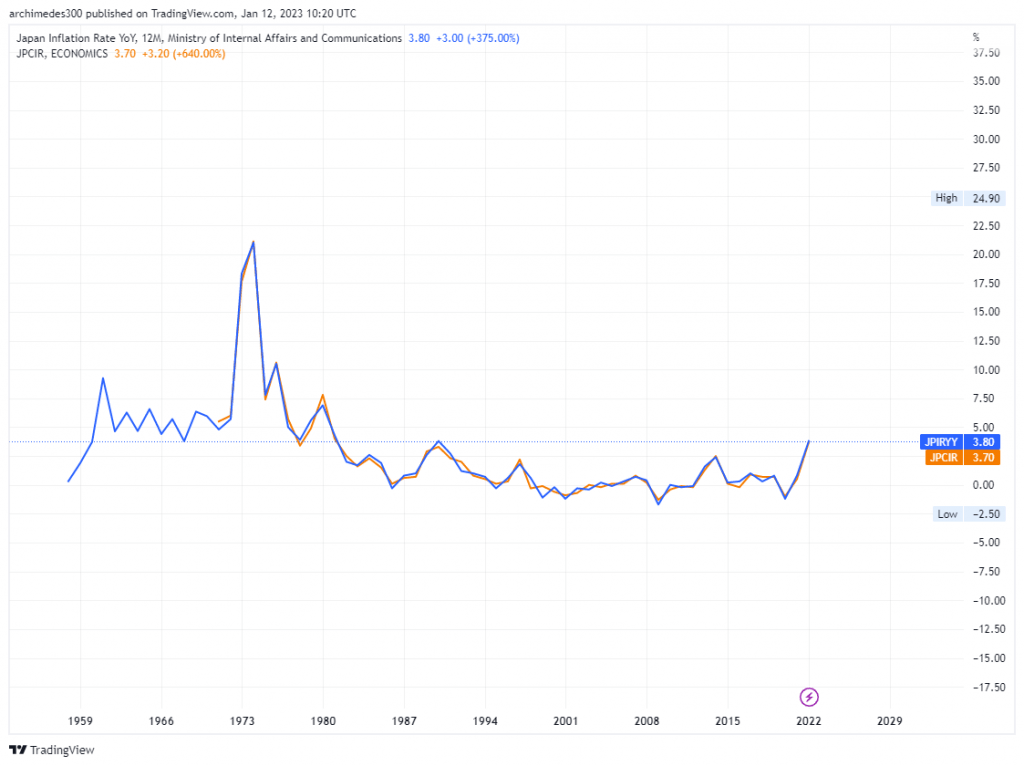How will drift the USD/JPY exchange rate? More Dollar strength shouldn’t be ignored
Dollar/Yen chart 12 months timeframe. Every candlestick= 12 months. USD/JPY 105.95 | 106.0 exchange rate has seen the largest volume traded. However, although the BoJ has very large USDollar reserves to help the Yen not depreciate too much. exchange rate Dollar/Yen up to 200.0, that would see a multi-decade strengthening of the Japanese Yen, simply reversing. This will have few derivative effects on the Japanese Economy. The depreciation of the Japanese Yen will improve Japanese Exports, but also higher inflation.

At moment it has been possible to observe that the higher than usual CPI Inflation data in Japan are very much correlated with Trade of Balance Deficit, something very unusual for Japan. This could potentially see some important shifts in the macroeconomic framework for Japan. Also, could be very much a possibility that the Japanese Government and the BoJ would continue within the same monetary and fiscal policy frameworks utilized in the past decades. However, the exchange rate depreciation of the Yen with more competitive exports could be a change approach towards improving Japanese exports competitiveness. Depreciation of the Japanese Yen could see higher Inflation that would require higher interest rates, however, the BoJ seems to have managed to control the Yield curve and JGBs market. There could be space for maneuvering the exchange rate, which would depend on how the Japanese economy intends to participate in the global economy, not only providing capital flows, but also capital goods and highly technological semi-manufactured and manufactured products, becoming more affordable with a lower Yen exchange rate.
Japan CPI and Core CPI 3.8% | 3.7%. Y? The Japanese Balance of Trade has seen a consistent deficit for the past 18 months. The higher CPI and CORE CPI data are very much correlated to Trade Balance Deficits.

Japan’s trade deficit surged sharply to JPY 2,027.4 billion in November 2022 from a JPY of 973.6 billion in the same month a year earlier and compared with market consensus of a gap of JPY 1,680.3 billion. This was the 16th straight month of the deficit which was the longest stretch since 2015, adding to concerns over the strength of the country’s economic recovery. Imports climbed 30.3% yoy to JPY 10,864.9 billion, while exports grew at a softer 20.0% to JPY 8,837.5 billion. Considering the first eleven months of the year, Japan logged a trade gap of JPY 18,417.0 billion, compared with a surplus of JPY 415.4 billion in the corresponding period in 2021. Meantime, the country’s trade deficit for the first half of FY 2022/2023 stood at JPY 11 trillion, the largest on record.

The depreciation of the Japanese Yen could become a tailwind for Japanese Exports, and that could in part provide ways of reducing the stock of public debt. While also, a large depreciation of the Japanese Yen could make NIKKEI225 equities much more interesting to investors. Of course, easier said than done, but Japan could try to make a π inversion to the older economic framework, lower the Japanese Yen, and competitive exchange rate, while also boosting Japanese goods exports of high-quality technology.
